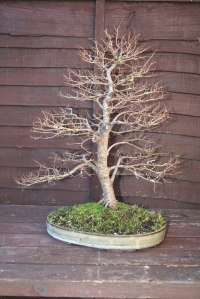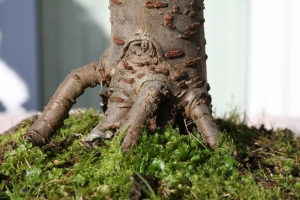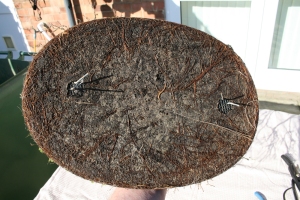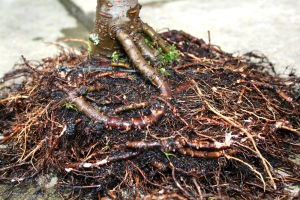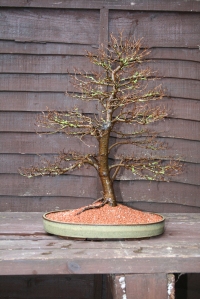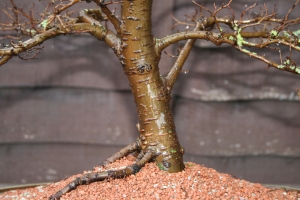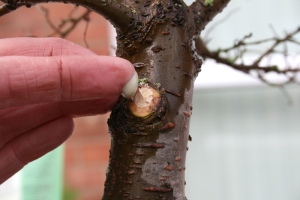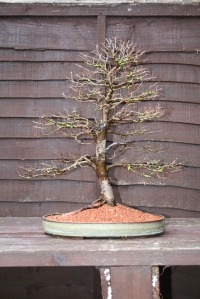After leaving my little Siberian Elm in basic soil for a year so it became accustomed to its new shallow pot, now is the time to remove it, replace the soil and restyle the branch structure.
Here’s a step-by-step guide to what happened along the way…
The Siberian Elm Bonsai was looking a little tired and neglected in its shallow pot. But it’s certainly healthy, with many new buds forming, and offered plenty of promise.
One aspect of this Bonsai that I am not too keen on is the nebari (root structure). There are four very strong roots that grow from the trunk at weird angles that form arches above the soil – I had to do something to make the most of them and try to make them look more realistic. I could remove them completely, but then it would lose that ‘established’ look. So the only alternative was to try to do something that might make them a little more appealing.
After removing the tree from its pot I found the roots to be really healthy. Although it’s been in the pot for 12 months it wasn’t pot-bound and only a slight amount of work was needed to trim the roots. The most necessary part was to remove as much of the old soil as possible to replace it with the usual soil substrate I usually use.
So I set to work with a Bonsai root rake – the single-pronged version. I prefer this style of root rake as it’s easier to use having the single prong, and it’s far less ‘violent’ than the triple-pronged rakes that are available.
After stripping the vast majority of the soil and opening up the roots I found the usual thing had happened – there was a long ring of roots growing around the pot’s circumference. The root system in the centre was spot on – no problems there – nice and healthy with plenty of new growth. Daisy – my daughter’s rabbit – thought so too.
After rinsing the roots well with the hosepipe and root pruning the excess I was left with a nice, compact root ball that would easily fit within the pot, allowing me to reposition the tree at the new angle I desired. The next stage would be to take a look at the root system…
As you can see, the main side roots or nebari grow from the trunk quite high, leaving a gap between the root and the soil as they curve back into the soil at a fairly severe angle. I don’t like this at all really, so had to get my thinking cap on.
Wiring wasn’t possible as I had to lift the roots up to reduce the angle that they return to the soil. Having a look around the garden I found the perfect solution to the problem – pebbles. So I picked a couple that were smooth and the ideal size, lifted the strong roots up as high as I could without splitting them, and pushed the pebbles underneath to support them, and help reduce the angle. Problem solved!
The soil substrate I use for my Bonsais is cheap, easy to use, offers great water retention, is free-draining, it provides the roots with gaps to breathe and is easily available – it’s Tesco’s Low Dust Lightweight Cat Litter. At a mere £3.50 for 10 litres, it’s far, far cheaper than Akadama and it works just as well.
I also add a sprinkling of Empathy Rootgrow to the cat litter – a Mycorrhizal Fungi that helps promote new, strong and healthy root growth. This costs around £9.00 for 360 grams, but providing it is kept dry it will last for many, many years as you only need a tiny amount adding to the soil each time you re-pot a Bonsai.
After having a look through my Bonsai pot collection, placing the tree inside a few, I couldn’t find anything more suitable than the pot it was in initially, so I cleaned it up thoroughly inside and out, added new drainage hole mesh and set to work replacing the tree.
I poured a little of the cat litter into the pot and spread it around evenly, then positioned the tree over the top. After moving it around I finally decided upon the angle and positioning of the trunk, passed a length of wire through the pot’s drainage holes, through a large section of the root system, then back through the other pot drainage hole and pulled tight to lock the tree in place within the pot.
Once the soil was in place I could begin trimming and pruning the branches to style the Bonsai ready for this Spring’s new growth, and also take a look at one of the branches at the base. Having turned the tree around to make the most of the root system and an old gnarled section upon the upper part of the trunk, the first back branch didn’t look right.
As there is a branch positioned above this nuisance back branch that could quite easily be bent into position to help fill the negative space with foliage I was quite happy to reach for the branch cutters and take it off completely. Once removed and cut back as far as I could to the trunk’s bare wood I smeared a little wound healing paste over the cut just to help it along.
I set to work with the little pruning scissors to tidy up the apex of the Bonsai and shape the side branches, and then used a short length of wire to pull down the new first back branch to fill in the negative space created when I removed the lowest back branch and here’s the finished tree, after watering thoroughly with a little added seaweed for added nutrients. Finger’s crossed it will be a success this coming year, and for many years to come…
If anyone has any comments or advice that may help make this tree even more appealing, please feel free to add them – I’d appreciate it. And so would the tree!

